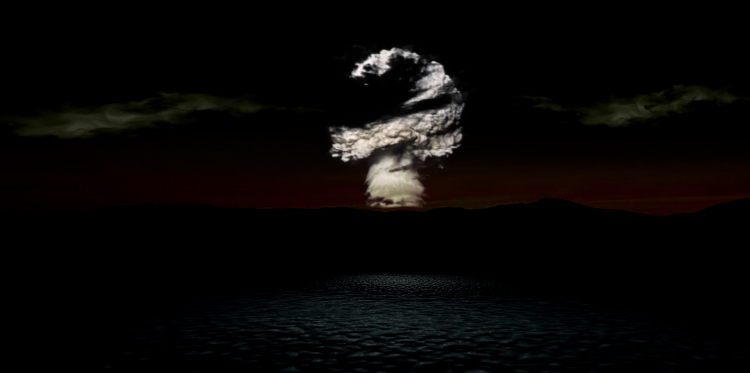
November 2017:
24.11.17 – 14.01.18
Finissage 12.01.2018 – 7 p.m.
OKK exhibition with contributions from:
Jan Bejšovec, Nicolás Boillot, Richard Clauss, Pablo Dodogson, Lisa Glauer, Isao Hashimoto, Pablo Hermann, Neža Peterle and Sencer Vardarman
[ A Bomb is an explosive weapon that uses the exothermic reaction of an explosive material to provide an extremely sudden and violent release of energy. ]
[ A nuclear bomb is an explosive device that derives its destructive force from nuclear reactions, either fission or from a combination of fission and fusion reactions. It is a weapon of mass destruction.]
There was no more treathening menace for mankind during the 20th century than an man made catastrophy by massive use of nuclear weapons. This threat is build and symbolized by one singular term: „the nuclear bomb“, or simply „the bomb“. During the cold war the military escalation between the Soviet Union and the U.S. lead us several times towards the edge of an atomic war, which surely means the end of zivilisation and very probably also the end of mankind.
“moonlight” digital Print, Sencer Vardarman
During that period the DEFCON 1 (defence readiness conditions – imminent nuclear war) fortunately never was called out but for example the Cuban-Crisis or the history of Stanislav Petrov tells us that we had been very close to it. With a peak of 64.449 nuclear bombs in 1986 – now there are officially 9.435 active atomic devices – mankind is able to destroy the complete planet several dozens of time. (source: bulletin of the atomic scientists (1)).
Nevertheless “the nuclear balance” between the super-powers provided “peace” for decades in Europe, when otherwise a military confrontation would have been unavoidable. It forced the USSR and the USA to outsource their conflicts into the so-called Third World, turning local conflicts into major wars like in Korea, Vietnam or Afghanistan.
After the cold war the ongoing disarmament and considerable reduction of weapons of mass destruction the bomb was not in the mind of the people anymore. A lot of people thought this ghost went away with the end of the tensions between east and west, between the Warsaw Pact and the NATO. But today we are remembered to the old times when we see Kim Jong Un together with his counterpart Trump. Two Leaders, who can unleash a nuclear disaster at any moment. The photographs of Hiroshima get present in the mind by a singular switch in the TV. The Doomsday–Clock is two and a half minutes before 12, researched and calculated by the scientists of the already mentioned bulletin (2).Not only the use of nuclear power for military purposes is a massive threat, it is also the use for civil energy supply. When Chernobyl blew up the mantra of the nuclear industry was, that it is a singular case and such a MCA (maximum credible accident) happens only all few thousand years. Fukushima and a list of several other incidents are testimonies of the danger of nuclear technology (3). And the big problem we are giving as heritage for our descendants, the storage of the atomic waste, is not resolved at all.
This overwhelming, scary and threatening entity „the bomb“ is the initial moment of countless works in graphic, film and literature and it is constantly inspiring people for works about the biggest monster mankind was able to create. The image of the bomb mushroom stands symbolically for fire, destruction, end and apocalypse like no one other image before. The bomb is the mystification and visualization of the ability of self-destruction of the supposedly most advanced being of the planet.
The destroyed cities of Nagasaki and Hiroshima are burned into the patina of the human soul, into the memory of our societies. But are we aware of the doom we are still creating?
he approach of the OKK exhibition: „THE BOMB“ is to sensitize the people towards this thematic and try to make clear the constant danger we are exposed to. This sensitisation should happen in an aesthetic and more poetic approach, due to the fact that all rational channels of information are oversaturated and full of media-war propaganda. Nevertheless the framework of the exhibition will show a list of activist and scientist information through a blog conceived for this project.
The OKK Team made of 4 board-members chose 4 colleagues to join this exhibition.
Nicolas Boillot will work with the visuals of explosions and the concept of dematerialisation as a new contextualisation of the bomb.
Jan Bejšovec started a production of textile bombs for an installation.
Richard Clauss works on acoustic landscapes by using decomposition and recomposition of explosions recopied in an audio installation.
Pablo Dodogson draws a series of poetic resignifications of pictograms related to the iconography towards the bomb.
Lisa Glauer presents a image of a nuclear reactor. The image is drawed by the use of human breast-milk.
Isao Hashimoto produces a video timelapse with the atomic explosions from 1945 until 1998. His research is about each nuclear blast effectuated including the data of nations, timeline, locations and potence of explosion.
Pablo Hermann will paint a huge size portrait of Stanislav Petrov, the soviet officer who saved the world from an inevitable chain-reaction towards a nuclear disaster.
Neža Peterle is preparing a photo-collage with visualisations of mushroom-clouds.
Sencer Vardaman presents his digital photographic work „moonlight“, which is a poetic and mystical approach starting from the image of an nuclear test explosion.
References:
thebulletin.org
thebulletin.org/doomsday-dashboard
Lists of nuclear disasters and radioactive incidents
List of military nuclear accidents
“1945 – 1998” work by Isao Hashimoto
